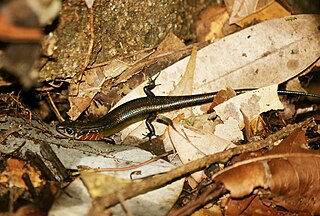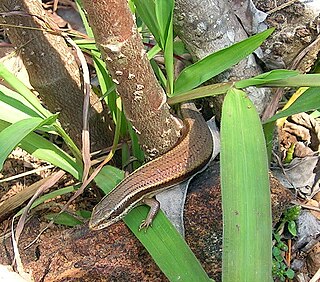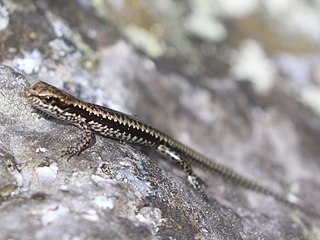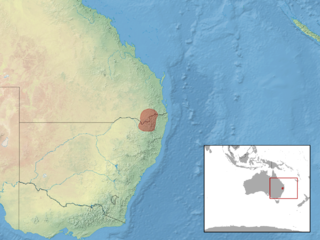
Skinks are lizards belonging to the family Scincidae, a family in the infraorder Scincomorpha. With more than 1,500 described species across 100 different taxonomic genera, the family Scincidae is one of the most diverse families of lizards. Skinks are characterized by their smaller legs in comparison to typical lizards and are found in different habitats except arctic and subarctic regions.

Ablepharus is a genus of skinks that contains the common snake-eyed skinks. Both their scientific and common names refer to the fact that their eyelids have fused to a translucent capsule; as in snakes, they thus are physically incapable of blinking. They are small lizards and prefer to live in the leaf litter of dry fields and hills. Their scales give them a very shiny, bronze appearance with a characteristically dark stripe down the sides of their bodies. They prey on small insects and other small mollusks.

Cryptoblepharus is a genus of skinks, lizards in the family Scincidae. The genus contains at least 53 species.

Eulamprus is a genus of lizards, commonly known as water skinks, in the subfamily Sphenomorphinae of the family Scincidae. The genus is native to Australia.

Lankascincus is a genus of lizards, commonly known as lanka skinks and tree skinks, in the family Scincidae. The genus is endemic to Sri Lanka.

Mochlus is a genus of skinks, lizards in the family Scincidae. The genus is endemic to Africa.

Parvoscincus is a genus of skinks, lizards in the family Scincidae. The genus is endemic to the Philippines.

Scincella is a genus of lizards in the skink family, Scincidae, commonly referred to as ground skinks. The exact number of species in the genus is unclear, as taxonomic reclassification is ongoing, and sources vary widely. Scincella species primarily range throughout the temperate regions of the world and are typically small, fossorial lizards, which consume a wide variety of arthropods. They are a generalized insectivore with well developed chemosensory abilities.

The genus Sphenomorphus – vernacularly also known as the common skinks – currently serves as a "wastebin taxon" for numerous skinks. While most or all species presently placed here are probably rather close relatives, the genus as presently delimited is likely to be not monophyletic and is in need of review. Some species in this genus have been moved to Pinoyscincus.

The western skink is a species of small, smooth-scaled lizard with relatively small limbs. It measures about 100 to 210 mm in total length. It is one of seven species of lizards in Canada. They spend much of their day basking in the sun. Their diet ranges widely, including spiders and beetles. Western skinks will bite if grasped and will flee if they feel threatened. It is a common but secretive species whose range extends from southern British Columbia and throughout Washington, Oregon, Nevada, Utah, Idaho, and Wyoming and into western Montana and northern Arizona and Missouri. They can also live in some areas of Texas It is widespread in northern California but primarily restricted to the coast in central and southern California. Found in a variety of habitats, this lizard is most common in early successional stages or open areas of late successional stages. Heavy brush and densely forested areas are generally avoided. Western skinks are found from sea level to at least 2,130 m (7,000 ft). This diurnal reptile is active during the warm seasons.

Blue-tongued skinks comprise the Australasian genus Tiliqua, which contains some of the largest members of the skink family (Scincidae). They are commonly called blue-tongued lizards or simply blue-tongues or blueys in Australia or panana in Indonesia. As suggested by these common names, a prominent characteristic of the genus is a large blue tongue that can be bared as bluff-warning to potential enemies. The type of predator/threat that is near will determine the intensity of colour present in the tongue. The tongue can also deform itself and produce a thick mucus in order to catch prey. They are relatively shy in comparison with other lizards, and also significantly slower due to their shorter legs.

Kaestlea travancorica, also known as the Travancore ground skink or Barbour's ground skink, is a species of skink endemic to southern Western Ghats.

Lygosominae is the largest subfamily of skinks in the family Scincidae. The subfamily can be divided into a number of genus groups. If the rarely used taxonomic rank of infrafamily is employed, the genus groups would be designated as such, but such a move would require a formal description according to the ICZN standards.

Eulamprus quoyii, more commonly known as the eastern water skink, eastern water-skink, or golden water skink, is a viviparous species of diurnal skink. Eulamprus quoyii belongs to the family Scincidae and is considered a common garden animal in Australia. The skink is endemic to Australia and found only along the east coast of the country. It makes its home in creekside habitats along the east coast of Australia and in urban garden areas with high amounts of moisture. The species can be identified by the twin, long yellow stripes that run along its body from the top of the eye, as well as by several more specific character derived states. The pale yellow dorsolateral stripes are most likely where its common name, the golden water skink, is derived. Like other ectotherms, the skink can often be seen basking in the sun on rocky outcroppings in order to regulate its body temperature. Its diet mainly consists of both aquatic and terrestrial insects, tadpoles and small amounts of plant matter. The skink both hunts for food and scavenges when necessary and is considered an opportunistic feeder. It is prey to larger lizards, snakes, cats and birds and so will often be seen moving quickly into hiding when other organisms are present.
Lankascincus taylori, commonly known as Taylor's tree skink, is a species of lizard in the family Scincidae. The species is endemic to the island of Sri Lanka.

Concinnia is a genus of skinks in the subfamily Lygosominae.

Kaestlea is a genus of skinks. These skinks are small, shiny, smooth-scaled species. They are diurnal, terrestrial and insectivorous. They lay eggs to reproduce. These skinks are identified by their distinct blue tail colour. They live in tropical rainforest and montane forest habitats. These secretive skinks silently move through thick leaf-litter on forest floor. They are all endemic to the Western Ghats mountains and in some parts of Eastern Ghats (Shevaroys) of South India.

Tytthoscincus is a genus of skinks. Originally defined to include a few species from the Philippines, the genus now includes many species from South-East Asia in general.

Silvascincus tryoni, the Border Ranges blue-spectacled skink or forest skink, is a species of lizard in the family Scincidae. It is endemic to the McPherson Range bordering New South Wales and Queensland, Australia.

The blue-speckled forest-skink is a species of skink found in Queensland and New South Wales in Australia.


















